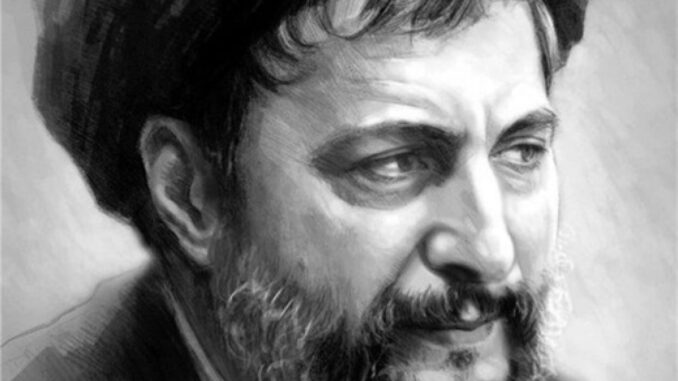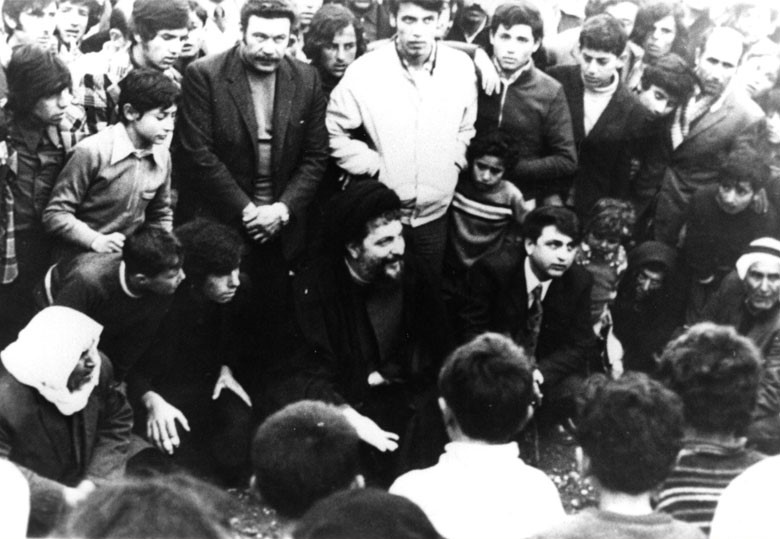
Description:
Lebanese university lecturer in history, Talih Kamal Hamdan, explores the role of the late Imam Musa al-Sadr in shaping a sense of national belonging and identity within the Shia sect in Lebanon, specifically during the 1960s and 1970s.
Understanding the historical formation of the national and political identity of the Shia of Lebanon is particularly relevant today, as contemporary Lebanese Shia Muslims are highly influential actors not only within Lebanon, but on the regional level as well. This is especially the case when viewed from the lens of Hezbollah, a group which considers itself an extension of the general political paradigm shaped by al-Sadr.
Source: Al Akhbar Newspaper
Date: September 8, 2015
(Important Note: Please help us keep producing independent translations for you by contributing as little as $1/month here )
Transcript:
Imam al-Sadr and his role in instilling a sense of national identity in Lebanese Shia
Talih Kamal Hamdan
This year marks the 37th anniversary of the disappearance of Imam Musa al-Sadr and his two companions, (an anniversary that) comes at the height of internal, regional and international conflicts; takfirism; and discrimination against sectarian and ethnic minorities in the Arab world, where Shias are the main target of Takfiri groups. The role of Shias in the Lebanese political reality is also being increasingly targeted by way of distorting their nationalist struggles, for which Imam al-Sadr laid solid foundations, and for which thousands of martyrs (of Shia origin) sacrificed their lives. (Many Shias) gave their lives (within these nationalist struggles) in order to free (their) land (from Israeli occupation), fighting (the occupation) as members of national and Islamic resistance groups successively (established) between 1975 and 2006.
The government’s neglect of the villages in the South (of Lebanon), the Beqaa, and Beirut suburbs; together with the deplorable conditions that farmers and their families lived under; and the overwhelming dominance of feudal families who had great political, economic and social influence in these areas, all these were starting points for (the establishment of) left-wing and progressive parties beginning in the mid-50s. These parties sought to fight deprivation, unilateralism of southern political representation, and the blatant denial of the rights of workers and farmers. However, these parties failed to establish social justice. Due to their fragmentation, differing frameworks and (political/ideological) poles, and their ordering of priorities that favored politics over other issues, these parties were not able transform their social standing into influence in the government, thus preventing them from turning the family structure into a national institutional structure. They chose cosmetic changes over (real) change, and social struggles with political and power-based objectives over a comprehensive social revolution. Then came the civil war in 1975 and toppled the social and national, non-sectarian movements, thus giving the upper hand to the 1943 (sectarian) formula only with new faces.
Since the mid-1960s, there had been growing social demand (for the rights of) marginalized groups, especially the Shia community who was suffering from the lack of institutions, jobs and services, and the scattering of its skilled individuals between left-wing parties and Palestinian organizations on the one hand, and opportunistic feudal leaderships on the other. As a result, unlike other Lebanese social groups, (the Shia community) lacked a specific identity. Therefore, the objective conditions made room for another kind of leadership, (a leadership) that seeks change, and mobilizes its resources to lift (people) from fragmentation to unity, and from a feeling of deprivation to a feeling of power; (a leadership that grants) the right to participate in the government and its administrative and functional departments, (the right to) social development, and (the right to) participate in local, regional and international political decision-making of the Lebanese state. All this on the basis of both a religious identity and a unified national vision. Thereafter, Imam Musa al-Sadr’s movement emerged to call for social and political reform as a priority, on the basis of the “Lebanization” of Shia decision-making, and (the Shia sect’s) integration into the Lebanese state, whom Shias had always felt abandoned by.

Initially, the influential feudal and religious families did not have a negative reaction to the emergence of Imam al-Sadr. However, (with time) his reform movement against traditional feudalism gained strength as he gained large public support. His work was culminated in the adherence of young secular individuals to his project thanks to his undermining of the religious legitimacy granted to the feudal leaderships. (He) took advantage of the political and social situation in the South, the Beqaa and the Beirut suburbs, to begin the process of comprehensive change of the role of Shias in Lebanon.
Imam al-Sadr took the social dimension as a priority, and fought for “ending the deprivation (of basic rights) in the Beqaa and the South”. He started by confronting his opponents from the traditional feudal leaderships, notably Kamel al-Assaad, and left-wing parties, especially the Communist Party, in order to prevent them from “manipulating the Shia youth ideologically and on the basis of party-loyalties.” (1)
Even though (Imam al-Sadr) held firm to his religious foundations, yet he used religion to sharpen the sense of belonging to a national identity, and worked on establishing a social identity that – similar to other sects – combined both patriotism and the exaltation of the (Shia) sect. He replaced family loyalty with religious sectarian loyalty, thus attracting various segments (of society) who had previously adhered to the (powerful) feudal families, or adhered to the left-wing parties with their (various) slogans. (Imam al-Sadr) also brought back the idea of institutionalizing religious identity by reviving the “Al Ber wal Ehsan” Charity (جمعية البر والإحسان) founded in 1948 by Sayyed Abd al-Hussein Charafeddine in (the city of) Tyre, making it a starting point for his social service activities, and a project similar to the Amel Association (الجمعية الخيرية العاملية) in Beirut. He then established the Supreme Islamic Shia Council in Lebanon in 1969, which was a major turning point (that struck at) the core of the traditional authoritarian leadership (of Lebanese Shias). He was also able to establish educational, professional and social institutions, after they were absent for many decades because of the (Lebanese) state’s failure (to provide) services and (build) institutions in the South and the Beqaa. By raising the awareness of Shias regarding their sectarian and national identity, (Imam Musa) wanted to stress that they are citizens who have the right to consistent development, to be relieved from deprivation, and protected against Israeli attacks (2).
He built multiple relations with many national and southern actors, and showed an outstanding leadership and a strong ability to influence Lebanese elites and the Lebanese people. Therefore, Sayyed (Musa) was granted Lebanese nationality in 1963 by President Fouad Shehab, and became a permanent guest at the Lebanese symposium, which was composed ofLebanese political and intellectual elites. Therefore, Sayyed Musa was described by Michel Asmar as a “man of the coming time”. He also established relations with famous media figures, especially Ghassan Tueni. However, despite his wide network of internal and external political relations (that he established) on the basis of supporting his reform project, he tried to make sure that his political line stays as independent as possible.
(Imam al-Sadr) was known for his boldness in objecting to the excesses of the (Lebanese) state against southern citizens who were suffering daily from Israeli attacks. As such, he declared a general strike to support the people of the South, and consequently, he established the Southern Council, then the Commission for Southern Support in cooperation with Cardinal Anthony Khreish and a large group of Muslim and Christian scholars and clerics. He also confronted the Palestinian resistance, despite his alliance with it, after its multiple excesses against the southerners. He addressed Abu Ammar (i.e. Yasser Arafat, Former Chairman of the Palestine Liberation Organization) saying: “Abu Ammar, I (am ready to) protect the Palestinian resistance (even) with my turban, but I will not be silent about its transgressions against people in the South” (3).
Accordingly, Imam al-Sadr is indeed the true father of “Lebanese political Shiism”, which considers the national dimension a priority in its internal movement, and which believes that Lebanon is the permanent home for all its sons and various other social groups, and (a country) that must be defended by all means and at all costs, not on the basis of hegemony and partisanship, but rather partnership and national belonging. This explains the (contemporary) Shia urgency and seriousness to protect Lebanon from both Israeli aggression and the Takfiri threat.
References
1- Abd Al-Raouf Sunno: “The Lebanese War 1975-1990: The Dismemberment of the State and the Rift within the Society”, Volume One, ibid, pg. 145.
2- Talal Atrissi: “The conditions of the Shiites of Lebanon have changed,” in: “The Shiites in Lebanon from marginalization to active participation,” ibid., pg. 245
3- “The Supreme Islamic Shiite Council and the Rights of the Sect,” a special booklet issued by the Supreme Islamic Shiite Council, January 1974, pg. 10.
——
Subscribe to our mailing list!

Sharafeddin’s son, Sadreddin, left Najaf for Isfahan, which was then the most important centre of religious learning in Iran. He returned to Najaf shortly before his death in 1847. The youngest of his five sons, Ismail ( The second son of Ismail, also named Sadreddin, was born in Ottoman Iraq and also decided to settle permanently in Iran. He became Musa al-Sadr’s father. While living in Iran, Sadreddin married a daughter of Ayatollah Hussein Tabatabaei Qomi, an Iranian religious leader. She would become Musa al-Sadr’s mother.